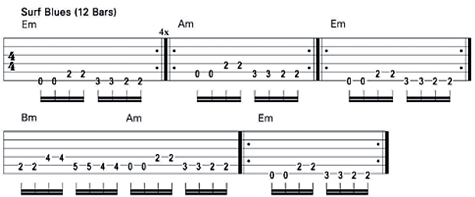Hey there, fellow pickers. I hope you’ve been practicing my previous lessons with your metronome and slowly building up speed. It will prepare you for this month’s lesson. If you’ve missed any of our previous topics, you can find them all at premierguitar.com.
This month, in line with this column’s title, I would like to begin teaching the basics of surf guitar. Having recorded the soundtrack to the surf classic, Endless Summer II, I learned a great deal about surf music, surf culture, and even had the honor to record with the King of Surf Guitar, Dick Dale.
When it comes to surf music, typically the guitar is drenched in high levels of reverb to emulate the sounds of the surf rolling in, but as always, you can adjust it to your taste. The tone is not real dirty, it’s more of a clean sound but big in tone. For the rockers, a crunch tone can also work (medium distortion).
Surf guitar involves very fast tremolo picking with the right hand and playing repetitive patterns with the left hand. Another technique often heard is sliding your left hand over the strings while running your hand down the neck and picking fast. This creates the sound of the waves crashing. When it comes to rhythm parts, a common effect used is tremolo. They come in small foot pedals and amps sometimes have them built in.
Of course, surf guitar is not as easy as it sounds. You don’t have to know how to surf or even love surf music, but it’s a style you should study. Keep your mind open to all types of music, because diversity is what makes a great musician. Playing different styles of music can get you out of a rut. I grew up playing blues, rock, funk, surf, jazz, country and basically whatever gave me a new challenge. Here are a few examples to add surf to your guitar vocabulary.
Exercise 1) 
This is an exercise using a harmonic minor scale, similar to the scale used in the surf classic made famous by Dick Dale, “Misirlou.” Try recording the chord progression E major to F major for 5 minutes, and then play the scale up and down the neck. Your goal should be to reach 180 beats per minute, but take your time getting there.
Exercise 2) 
This is the same as example 1, but now you are playing on the low E string. Many classic surf songs are built around open string playing.
Exercise 3) 
Now we’re cooking! This will put your tremolo picking to the test. Start slow – about 55 beats per minute – and try to reach 180 beats per minute. Always use the approach I gave in my earlier columns to speed up: every 60 seconds, increase your metronome’s speed one click.
Exercise 4) 
You should use a tight muting technique to create a surf/spy sound on this one. Surf music has a big connection to the blues, as many of the riffs are built on a I-IV-V blues progression. It’s common to hear an open string riff that is repeated over a I-IV-V. Try recording the open minor chords and play the riff over it.
If you’re new to playing surf guitar, try checking out Dick Dale, the Safaris or the Ventures for a taste of some classic surf. For a more modern approach to surf rock, check out my CDs, Monster Surf or Endless Summer II. Keep shredding, surf’s up!
Gary Hoey
you can email Gary at: info@garyhoey.com
garyhoey.com
myspace.com/garyhoey











![Rig Rundown: Russian Circles’ Mike Sullivan [2025]](https://www.premierguitar.com/media-library/youtube.jpg?id=62303631&width=1245&height=700&quality=70&coordinates=0%2C0%2C0%2C0)













